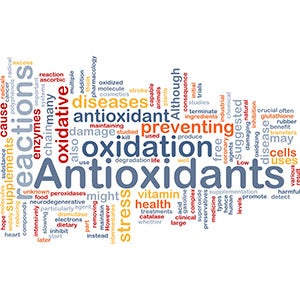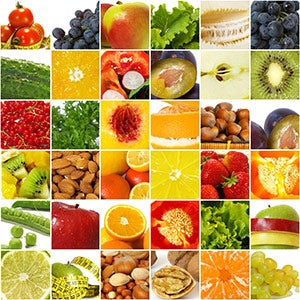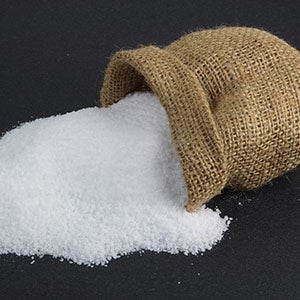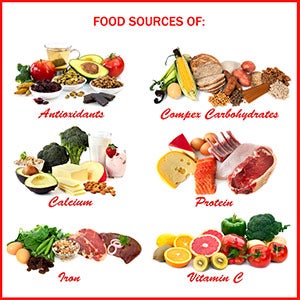A-Z OF KIDS HEALTH AND NUTRITION
If you are one of those people who are clueless when it comes to knowing your vitamins and nutritional terms, then our A to Z terminology list will help you to wise up. If a nutritional term had you confused or curious in the past, it will surely be something of the past after you have read our easy to read list, so go ahead and wise up on your health terminology and find everything you need to know right here.
A to Z of Nutrition A Acidophilus (Lactobacillus Acidophilus)
Acidophilus is a probiotic bacteria that is commonly found in yoghurt. Probiotic bacteria survive digestion in the stomach and help to maintain the balance of ‘good bacteria’ in the lower parts of the intestinal tract. A good balance of these ‘friendly’ bacteria in the intestine reduces the risk of health problems.
Additives
Additives are used to preserve food and in most cases to improve its taste, appearance, quality and stability. Many of the substances used as food additives also occur naturally in foods. Food additives are listed in the ingredients list of packaged foods and are described by their function in the food, followed by either the specific name or the number unique to each additive e.g. emulsifier (322). Food additives are given code numbers to make them easier to identify as their names can sometimes be long and complicated. The type and level of additives used in foods in South Africa is regulated by the Food Standards Code.
Amino Acid

Anaemia refers to a variety of conditions in which the concentration of hemoglobin, an oxygen carrying molecule in the blood, is reduced Amino acids are the building blocks of protein. There are 20 different types that are combined in different ways to make different proteins. The body can produce some of its own amino acids, but some are essential which means that they cannot be made by the body therefore we need to get them from the foods we eat.
Anaemia
Anaemia refers to a variety of conditions in which the concentration of haemoglobin, an oxygen carrying molecule in the blood, is reduced. Common symptoms of anaemia are tiredness and fatigue. The most common causes of anaemia are iron deficiency, folate deficiency and/or vitamin B12 deficiency (pernicious anaemia). The most common Iron deficiency in South Africa is anaemia and it is caused by inadequate intake of foods rich in iron. Foods containing Iron include red meat, seafood, poultry, wholegrain breads, cereals, nuts, legumes and green leafy vegetables. The iron in meat, seafood and poultry is better absorbed than that in plants. Another type of anaemia is pernicious anaemia which occurs when the body lacks intrinsic factor (the substance that helps the body absorb vitamin B12 from food). Pernicious anaemia is a result of vitamin B12 deficiency.
Antioxidants
Antioxidants are compounds that protect the body against damage caused by free radicals. The body produces its own antioxidants and they are also found in foods such as fruits and vegetables, tea, coffee, dark chocolate and red wine. The most common antioxidants are vitamins C, E and A, and phytochemicals like polyphenols. Eating a diet rich in antioxidants is beneficial for your health and wellbeing.
Aspartame
Aspartame is an artificial sweetener made up of two amino acids – aspartate and phenylalanine. These amino acids are found naturally in foods like meat, vegetables, dairy products and cereal grains. On their own these amino acids are not sweet, but together they produce an intense sweet taste that is approximately 200 times sweeter than sugar.
B Body Mass Index (BMI)
The body mass index is one way to assess whether a person is in the healthy weight range for their height. You calculate your BMI by dividing your weight in kg by your height in metres squared (BMI = kg/m2). People with a BMI between 18-25 kg/m2 are considered a healthy weight, whereas a BMI of 25-30 kg/m2 is considered as overweight and a BMI over 30 kg/m2 means that you are obese.
C Caffeine
Caffeine is a natural chemical found in plants and the most common sources are coffee beans, tea leaves, guarana berries and smaller amounts are found in cocoa beans. Caffeine acts as a stimulant to the nervous system in the body, increasing mental alertness.
Calcium
Calcium is a mineral that is also an important component of our bones. Dairy products such as yoghurt, milk and cheese are rich sources of calcium, and it is also found in canned salmon and sardines with bones, some nuts, seeds and fortified foods such as soy products, orange juice and cereals.
Calories (Cal)
Calories are a unit of energy. In Australia it is more common to use kilojoules (kJ) as the unit of energy. One Calorie is equal to about 4.18 kilojoules.
Carbohydrates
Carbohydrates are short or long chains of sugars that play an important role in the diet and are used to supply the body with energy. Sugar, starch and cellulose are all types of carbohydrates. Bread, cereals, rice, pasta, legumes, fruit and some vegetables are all good sources of carbohydrates.
Cardiovascular Disease
Cardiovascular disease is a name given to a group of diseases that affect the heart and/or our blood vessels and includes stroke, heart attack, angina and high blood pressure.
Chicory
Chicory is a plant which roots can be roasted, ground and used to make a hot beverages like coffee or tea substitutes, but unlike regular coffee and tea, chicory contains no caffeine.
Cholesterol
Cholesterol is a fat-like substance that has important functions in the body including an integral part of the structure of cells and being used by certain glands for making sex hormones. There are two types of cholesterol in the blood: HDL (high density lipoprotein) or ‘good’ cholesterol and LDL (low density lipoprotein) or ‘bad’ cholesterol. High levels of LDL in the blood can increase the risk of cardiovascular disease.
Cholesterol
Cholesterol is a fat-like substance that has important functions in the body including an integral part of the structure of cells and being used by certain glands for making sex hormones. There are two types of cholesterol in the blood: HDL (high density lipoprotein) or ‘good’ cholesterol and LDL (low density lipoprotein) or ‘bad’ cholesterol. High levels of LDL in the blood can increase the risk of cardiovascular disease.
D Diabetes
Diabetes is a condition in which the body has difficulty controlling the level of glucose (sugar) in the blood. There are three types of diabetes: type 1 (previously called insulin dependent) where insulin is no longer produced; type 2 diabetes mellitus (previously called non-insulin dependent) where the body does not respond well to insulin or the insulin that is produced does not work properly. And lastly there is also gestational diabetes which is type 2 diabetes that can occur during pregnancy.
Dietary Fibre

Dietary fibre is a type of carbohydrate that cannot be digested. There are three types: insoluble fibre, soluble fibre and resistant starch. Insoluble fibre keeps the bowel regular by absorbing water which softens the bowel contents. It is mostly found in wheat based foods such as bread and cereals as well as in nuts, seeds, fruit and vegetables. Soluble fibre is mostly found in fruits, vegetables, oats, dried beans and peas. It slows down the emptying of the stomach and makes people feel full for longer. Resistant starch is not digested in the small intestine, but moves to the large intestine where it is fermented by good bacteria to produce substances that help keep the lining of the bowel healthy.
Echinacea
Echinacea is a flowering plant that is often used as an herbal remedy to provide support for the body’s immune system and helps to reduce the risk of minor infections.
Electrolytes
Electrolytes are the term used for minerals in solution. Some of the main electrolytes in the body are sodium, potassium, calcium, magnesium, chloride and phosphate. Minerals play an important role in processes within the body such as nerve and muscle function and fluid balance. The body loses a lot of electrolytes when fluids are lost due to vomiting, diarrhoea and heavy sweating.
Emulsifiers
Emulsifiers are food additives that are added to foods to help mix oil and water ingredients. The most common emulsifier used in food is soy lecithin.
Energy
The body is provided with energy when carbohydrates, fats, proteins, dietary fibre and alcohol are broken down. Food energy is measured in kilojoules (kJ) or calories (Cal). It is the fuel that our bodies need for bodily functions such as breathing and digestion and everyday activities we do as well as any physical activity. The average person’s daily energy requirements differ depending on his or her age, sex, body weight and activity levels.
Essential Fatty Acids
Essential fatty acids are types of fat that are needed for the proper function and development but need to be taken in from the diet since they cannot be produced by the body. The two essential fatty acids are linoleic acid (an omega-6 fatty acid) and alpha-linolenic acid (an omega-3 fatty acid). Good sources of linoleic acid include polyunsaturated oils, margarines, some nuts (e.g. walnuts) and some seeds (e.g. sesame). Good sources of linolenic acid include canola oil, flaxseed and walnuts.
F Fat
Fat is an essential macronutrient used by the body for functions like insulation, protecting organs, as a store of energy and to supply fat soluble vitamins (A, D, E and K). The types of fats include saturated fat, monounsaturated fat, polyunsaturated fat and trans fat. Nutritionists suggest we limit the intake of saturated fat and trans fat in the diet.
Flavonoids
Flavonoids are a type of polyphenol (a group of plant chemicals) with a similar chemical structure that can also act as antioxidants in the body. Sources include wine, grapes, apples, tea, onions and berries. Flavonoids are found in small amounts in most vegetables and fruit.
Flavours
Flavours are a category of food additives that are added to food to impart a desired flavour. There are three classes of flavours, natural, nature identical and artificial.
Fluids
Fluids refer to the amount of liquid that we need on a daily basis. Our bodies are made up of a high percentage of liquid, and we need to replenish our fluid losses often. A person’s daily fluid needs depend on factors like age, environment and activity levels. We get fluids from both the food that we eat and the liquids that we drink.
Folate
Folate is a B vitamin that occurs naturally in green leafy vegetables, fruits like bananas and oranges, legumes and peanuts. Folate is also added to some breakfast cereals. It is needed in the body for proper cell development. It is vital that pregnant women have an adequate intake of folate during pre-pregnancy as well as in the first three months of pregnancy to help reduce the risk of foetal neural tube defects.
Free Radicals
Free radicals are highly reactive compounds that are produced in the body as a product of normal metabolic process as well as outside influences like smoking, air pollution and sunlight exposure. If the level of free radicals in the body is not controlled they can cause damage to cells. Antioxidants produced in the body or consumed from the diet help to control the level of free radicals.
Fructose
Fructose is a monosaccharide (sugar) which is a natural ingredient in fruit and honey. It is the sweetest natural sugar and is the product of the combination of glucose and fructose. Fructose is also used as a sweetener in some processed foods.
Glucose

Glucose is a monosaccharide (sugar). Foods rich in carbohydrate are broken down during digestion into glucose. The body’s cells use glucose to produce energy to fuel the body. Sometimes the words blood glucose and blood sugar are used interchangeably.
Gluten
Gluten is a type of protein that is found in cereal plants like wheat, barely, rye, triticale and oats. Lots of people are allergic to gluten.
Glycemic Index (GI)
The Glycemic Index (GI) is a ranking of carbohydrate containing foods according to the effect they have on blood glucose levels. Low GI carbohydrates are broken down by the body slower and result in a more gradual rise in blood sugar levels. High GI carbohydrates are broken down more quickly and result in more rapid increase in blood sugar levels. A GI of less than 55 is considered low, 56-69 is considered medium GI and a GI of 70 or over is considered high. Low GI foods are useful for persons with type two diabetes mellitus because it can to help with the control of blood glucose levels. High GI foods can be useful for sportspeople as a more rapid source of glucose to fuel working muscles. GI is best used to compare foods with similar carbohydrate contents, such as comparing one bread with another or one breakfast cereal with another cereal.
Glycemic Index (GI)
Glycemic Load (GL) Glycemic load, like GI (Glycemic Index), is a way of ranking carbohydrate containing foods. However, the glycemic load takes into account both the GI of the food and the amount of carbohydrate in a serve of the food. GL= (GI X carbohydrate per serve of a 100g) A GL of 20 or more is high, a GL of 11 to 19 inclusive is medium, and a GL of 10 or less is low. Because it takes into account the amount of carbohydrate in a food, the GL is best used to determine the overall impact on blood glucose levels of foods of different types.
GMO (Genetically Modified Organisms)
Genetically modified organisms are organisms that have been modified via the introduction of genetic material and proteins from another source. The policy on genetically modified organisms (GMO) and genetically engineered (GE) foods in Africa: The Cartagena protocol on biosafety, a supplement to the convention on biological diversity, has strong support in Africa, with a majority of the countries as signatories. In addition, several countries have, in the past, rejected aid (especially unmilled grains) in food imports with concerns for national biosafety. South Africa is so far the only country that is seeing wide-spread use of genetically modified crops. All foods produced using GM technology must undergo a pre-market safety assessment and mandatory labelling requirements.
H Haem iron
The iron found in animal products is called haem iron. ‘Haem’ iron is found in high amounts in red meat and offal. White meats such as fish and chicken also contain haem iron but not as much that can be found in red meat. The general rule of thumb is the redder the meat, the more iron it contains. Haem iron is more efficiently absorbed by the body than non-haem iron which comes from plant sources.
Halaal Foods
Halaal foods are those that are free from any component that is considered unlawful in Islam. They are processed, made, produced, manufactured and/or stored using utensils and equipment that have been cleansed according to Islamic law. There are several organisations in South Africa that certify foods as foods as being Halaal.
Hydrogenated Fats
Hydrogenated fats are vegetable fats that have been chemically altered by the addition of hydrogen (hydrogenation) with the purpose of making them more solid. Turning liquid oil into a more solid form makes it more stable for use in food manufacturing. Sources of hydrogenated fats include some cooking margarines, biscuits, cakes, pies and popcorn and many commercial frying oils.
I Insoluble Fibre
Insoluble fibre is a type of dietary fibre that is found in cereals and the outer skins of some fruit and vegetables, nuts, seeds and often in high fibre breads. Insoluble fibre absorbs water in the large intestine which helps to soften bowel contents and promote regularity.
Insulin
Insulin is a hormone that is produced by the pancreas in response to the food we eat. Insulin’s main role is to take glucose from the blood and move it into the body’s cells so that the cells can use the glucose for energy.
Inulin
Inulin is a type of soluble fibre found in some plants. Inulin has a positive effect on the body by promoting the growth of beneficial intestinal bacteria. Because of this effect, inulin is known as a prebiotic.
Iron
Iron is a mineral that is used by the body to make haemoglobin, the part of the red blood cell that transports oxygen. Iron-containing foods include red meat, poultry, legumes, green leafy vegetables and whole grain breads and cereals. A lack of iron in the diet or poor absorption thereof can lead to anaemia, an iron deficiency.
K Kilojoules
Kilojoules (kJ) are a unit measure for energy. In South Africa we use kilojoules as our standard measure, but Calories can also be used. One calorie is the equivalent of 4.18kJ.
L Lactose
Lactose is the sugar that occurs naturally in milk. It is a disaccharide that is made from 2 sugars joined together (glucose & galactose).
M Macronutrient
Carbohydrates, fat, proteins and alcohol are macronutrients. Macronutrients supply the body with energy. We need macronutrients (with the exception of alcohol) in larger amounts than vitamins and minerals which are called micronutrients.
Maltodextrin
Maltodextrin is a polysaccharide (long chain of sugars) produced from corn or wheat starch that is used as a food additive in many commercial foods including confectionery, snacks and desserts.
Micronutrient

Micronutrients are essential nutrients like vitamins and minerals that are required by our body in small quantities. Micronutrients are needed to help maintain proper health and functioning of the body.
Minerals
Minerals are compounds that occur in rocks and metal ores. Plants absorb minerals through the soil, and animals get these minerals by eating the plants or by eating other animals. Some of the major minerals required by the body include calcium, phosphorus, magnesium, sulphur, potassium, chloride and sodium. Trace elements are minerals needed by the body in smaller amounts such as iron, zinc, iodine, selenium, copper, manganese, fluoride, chromium, molybdenum.
Monosodium Glutamate (MSG)
Monosodium glutamate better known as MSG occurs naturally in some foods like mature cheeses, tomatoes, mushrooms and soy sauce. MSG also functions as a flavour enhancer and is sometimes added to savoury products like soups, sauces and stocks. It is displayed in the ingredient list as “flavour enhancer (monosodium glutamate)
